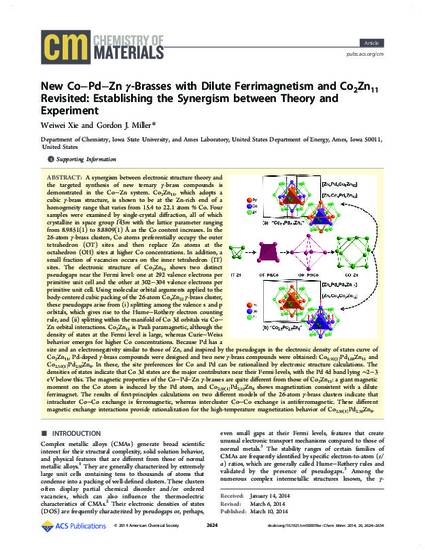
A synergism between electronic structure theory and the targeted synthesis of new ternary γ-brass compounds is demonstrated in the Co–Zn system. Co2Zn11, which adopts a cubic γ-brass structure, is shown to be at the Zn-rich end of a homogeneity range that varies from 15.4 to 22.1 atom % Co. Four samples were examined by single-crystal diffraction, all of which crystallize in space group I4̅3m with the lattice parameter ranging from 8.9851(1) to 8.8809(1) Å as the Co content increases. In the 26-atom γ-brass clusters, Co atoms preferentially occupy the outer tetrahedron (OT) sites and then replace Zn atoms at the octahedron (OH) sites at higher Co concentrations. In addition, a small fraction of vacancies occurs on the inner tetrahedron (IT) sites. The electronic structure of Co2Zn11 shows two distinct pseudogaps near the Fermi level: one at 292 valence electrons per primitive unit cell and the other at 302–304 valence electrons per primitive unit cell. Using molecular orbital arguments applied to the body-centered cubic packing of the 26-atom Co4Zn22 γ-brass cluster, these pseudogaps arise from (i) splitting among the valence s and p orbitals, which gives rise to the Hume–Rothery electron counting rule, and (ii) splitting within the manifold of Co 3d orbitals via Co–Zn orbital interactions. Co2Zn11 is Pauli paramagnetic, although the density of states at the Fermi level is large, whereas Curie–Weiss behavior emerges for higher Co concentrations. Because Pd has a size and an electronegativity similar to those of Zn, and inspired by the pseudogaps in the electronic density of states curve of Co2Zn11, Pd-doped γ-brass compounds were designed and two new γ-brass compounds were obtained: Co0.92(2)Pd1.08Zn11 and Co2.50(1)Pd2.50Zn8. In these, the site preferences for Co and Pd can be rationalized by electronic structure calculations. The densities of states indicate that Co 3d states are the major contributors near their Fermi levels, with the Pd 4d band lying ∼2–3 eV below this. The magnetic properties of the Co–Pd–Zn γ-brasses are quite different from those of Co2Zn11: a giant magnetic moment on the Co atom is induced by the Pd atom, and Co2.50(1)Pd2.50Zn8 shows magnetization consistent with a dilute ferrimagnet. The results of first-principles calculations on two different models of the 26-atom γ-brass clusters indicate that intracluster Co–Co exchange is ferromagnetic, whereas intercluster Co–Co exchange is antiferromagnetic. These different magnetic exchange interactions provide rationalization for the high-temperature magnetization behavior of Co2.50(1)Pd2.50Zn8.
Available at: http://works.bepress.com/gordon-miller/67/

Reprinted (adapted) with permission from Chem. Mater., 2014, 26 (8), pp 2624–2634. Copyright 2014 American Chemical Society.